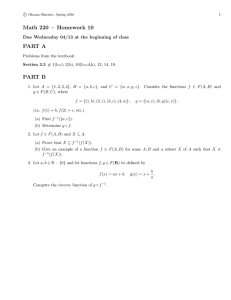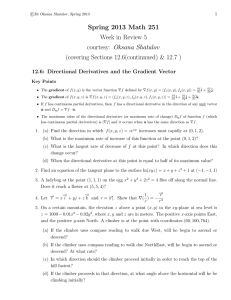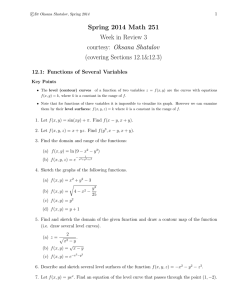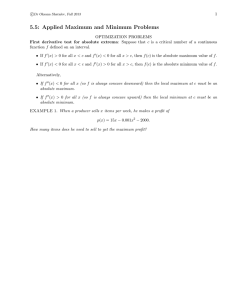Document 10582895
advertisement
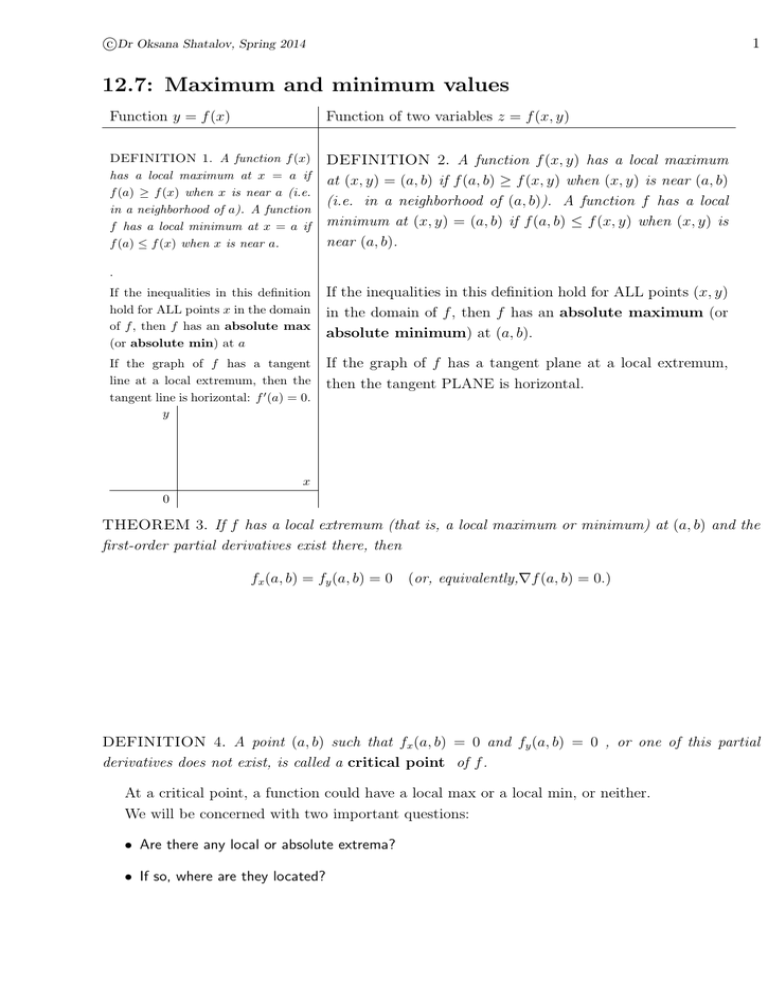
c Dr Oksana Shatalov, Spring 2014
1
12.7: Maximum and minimum values
Function y = f (x)
Function of two variables z = f (x, y)
DEFINITION 1. A function f (x)
has a local maximum at x = a if
f (a) ≥ f (x) when x is near a (i.e.
in a neighborhood of a). A function
f has a local minimum at x = a if
f (a) ≤ f (x) when x is near a.
DEFINITION 2. A function f (x, y) has a local maximum
at (x, y) = (a, b) if f (a, b) ≥ f (x, y) when (x, y) is near (a, b)
(i.e. in a neighborhood of (a, b)). A function f has a local
minimum at (x, y) = (a, b) if f (a, b) ≤ f (x, y) when (x, y) is
near (a, b).
.
If the inequalities in this definition
hold for ALL points x in the domain
of f , then f has an absolute max
(or absolute min) at a
If the inequalities in this definition hold for ALL points (x, y)
in the domain of f , then f has an absolute maximum (or
absolute minimum) at (a, b).
If the graph of f has a tangent
line at a local extremum, then the
tangent line is horizontal: f 0 (a) = 0.
y
If the graph of f has a tangent plane at a local extremum,
then the tangent PLANE is horizontal.
x
0
THEOREM 3. If f has a local extremum (that is, a local maximum or minimum) at (a, b) and the
first-order partial derivatives exist there, then
fx (a, b) = fy (a, b) = 0
(or, equivalently,∇f (a, b) = 0.)
DEFINITION 4. A point (a, b) such that fx (a, b) = 0 and fy (a, b) = 0 , or one of this partial
derivatives does not exist, is called a critical point of f .
At a critical point, a function could have a local max or a local min, or neither.
We will be concerned with two important questions:
• Are there any local or absolute extrema?
• If so, where are they located?
c Dr Oksana Shatalov, Spring 2014
2
SETS in R2
in R
close interval [a, b]
in R2
close set
open interval (a, b)
open set
end points of an interval boundary points
DEFINITION 5. A bounded set in R2 is one that contained in some disk.
THE EXTREME VALUE THEOREM:
Function y = f (x)
Function of two variables z = f (x, y)
If f is continuous on a closed inter- If f is continuous on a closed bounded set D in R2 , then f
val [a, b], then f attains an absolute attains an absolute maximum value f (x1 , y1 ) and an absolute
maximum value f (x1 ) and an absominimum value f (x2 , y2 ) at some points (x1 , y1 ) and (x2 , y2 )
lute minimum value f (x2 ) at some
in D.
points x1 and x2 in [a, b].
c Dr Oksana Shatalov, Spring 2014
3
EXAMPLE 6. Find extreme values of f (x, y) = x2 + y 2 .
Local
Absolute
Maximum
Minimum
Domain:
EXAMPLE 7. Find extreme values of f (x, y) =
Local
p
1 − x2 − y 2 .
Absolute
Maximum
Minimum
Domain:
EXAMPLE 8. Find extreme values of f (x, y) = y 2 − x2 .
Local
Absolute
Maximum
Minimum
Domain:
REMARK 9. Example 8 illustrates so called saddle point of f . Note that the graph of f crosses
its tangent plane at (a, b).
c Dr Oksana Shatalov, Spring 2014
4
EXAMPLE 10. Find the points on the surface z 2 = xy + 1 that are closest to the origin.
ABSOLUTE MAXIMUM AND MINIMUM VALUES on a closed bounded set.
THE EXTREME VALUE THEOREM:
To find the absolute maximum and
minimum values of a continuous
function f on a closed interval [a, b]:
To find the absolute max and min values of a continuous function f on a closed bounded set D:
1. Find the values of f at the critical
points of f in (a, b).
1. Find the values of f at the critical points of f in D.
2.Find the extreme values of f at the
endpoints of the interval.
3.The largest of the values from
steps 1&2 is the absolute max value;
the smallest of the values from steps
1&2 is the absolute min value.
2.Find the extreme values of f on the boundary of D.(This
usually involves the Calculus I approach for this work.)
3. The largest of the values from steps 1&2 is the absolute
maximum value; the smallest of the values from steps 1&2 is
the absolute minimum value.
• The quantity to me maximized/minimized is expressed in terms of variables (as few as possible!)
• Any constraints that are presented in the problem are used to reduce the number of variables to the
point they are independent,
• After computing partial derivatives and setting them equal to zero you get purely algebraic problem
(but it may be hard.)
• Sort out extreme values to answer the original question.
c Dr Oksana Shatalov, Spring 2014
5
EXAMPLE 11. A lamina occupies the region D = {(x, y) : 0 ≤ x ≤ 3, − 2 ≤ y ≤ 4 − 2x} . The
temperature at each point of the lamina is given by
T (x, y) = 4(x2 + xy + 2y 2 − 3x + 2y) + 10.
Find the hottest and coldest points of the lamina.
c Dr Oksana Shatalov, Spring 2014
6
Second derivatives test:
Suppose f 00 is continuous near a and
f 0 (c) = 0 (i.e. a is a critical point).
• If f 00 (c) > 0 then f (c) is a local
minimum.
• If f 00 (c) < 0 then f (c) is a local
maximum.
Suppose that the second partial derivatives of f are continuous near (a, b) and ∇f (a, b) = 0 (i.e. (a, b) is a critical point).
Let D = D(a, b) = fxx (a, b)fyy (a, b) − [fxy (a, b)]2
• If D > 0 and fxx (a, b) > 0 then f (a, b) is a local minimum.
• If D > 0 and fxx (a, b) < 0 then f (a, b) is a local maximum.
• If D < 0 then f (a, b) is not a local extremum (saddle point).
NOTE:
• If f 00 (c) = 0, then the test gives no
information.
If D = 0 or does not exist, then the test gives no information.
fails.
To remember formula for D:
f
f
xx xy D = fxx fyy − [fxy ]2 = fxy fyy EXAMPLE 12. Use the Second Derivative Test to confirm that a local cold point of the lamina in
the previous Example is (2, −1).
c Dr Oksana Shatalov, Spring 2014
EXAMPLE 13. Find the local extrema of f (x, y) = x3 + y 3 − 3xy.
Solution: Find critical points:
Calculate the second partial derivatives and D.
fxx =
fxy =
fyy =
D
7
c Dr Oksana Shatalov, Spring 2014
EXAMPLE 14. The mountain is defined by z = xy in the elliptical domain
x2
2
D = (x, y)|
+y ≤1 .
16
(a) Find the top of the mountain.
(b) Is the critical point found in the previous item the highest or the lowest in its neighborhood?
8
